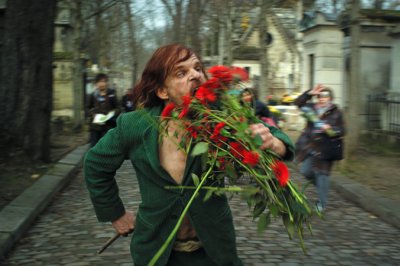Reviews - Holy Motors
Holy Motors
Reviewed By John Stakes

Holy Motors
Fantastic, bizarre, hallucinogenic, illogical, experimental, barking mad, kaleidoscopic, deranged, enigmatic, surreal, joyous and beautiful, are all descriptions applied in a futile attempt to delineate French director Leos Carax's fifth film and his first in fourteen years.
"Holy Motors", shown last Sunday, is Carax's attempt to explain or rather play-out his life and relationship with cinema which spans some thirty years. His opus is stuffed with actors he has used in the past, and Carax himself plays the opening scene character Le Dormeur as he unlocks and passes Narnia-like through a secret door into a cinema showing King Vidor's "The Crowd" whilst a huge black dog patrols the aisle, something no self-respecting cinema manager like Tom Rennie would likely tolerate!
His main star Denis Lavant, has played the character Alex in three of Carax's previous films but here plays Oscar, a man of many movie parts, revealing another nine here to be precise. Patrons were informed last Sunday that Leos Carax is an anagram of Alex and Oscar which also happen to be his two
forenames? And is this significant? Probably not!
Right from the off we realise that this film will challenge most if not all cinema's norms. And it does so in spades. The only way this reviewer could relate to it was not to try to understand all or any of the bizarre and visually striking sequences which make up the film, each one as unpredictable as the next, but to go along with the ride, slow at times though this proved to be. Carax refused to give press conferences to explain his film when it was unleashed on an unsuspecting public at the 65th Cannes Film Festival 2012 so why should any of us make the effort now? But read on please.
Safely cocooned within the dressing room confines of his white stretch limo, shielding him from the harsh realities of the outside world, Oscar (the director?) spent the whole of the film gloomily ruminating over his past life (having long since given up the task of distinguishing his acting roles from real life), and commenting on the world around him. Carax also wrote his own screenplay and ensured that obscuration prevailed probably with the intention of trying to present himself as someone who still did not know who he really was. And did we care?
Up to a point yes. Lavant as Oscar was impressive in all nine of his personifications, beating by one the previous record set by Alec Guinness as eight members of the D'Asgoyne family in the 1949 film "Kind Hearts and Coronets". Oscar was a poor man's Dr Who, accompanied by his female confidante and driver Celine, time-travelling in a parallel universe and returning to his limo-tardis only to take on his next assignment. With the aid of prosthetics and contributions from the wardrobe department, Carax's alter ego Oscar variously morphed into a wealthy industrialist, a beggar woman, Spiderman(?), mandarin, sewer living monster, controlling and abusive father, accordion player, gangster, and an old man. For each of his life's vignettes he mysteriously received folder instructions which, though failing to self-destruct (in "Mission Impossible" mode), became re-scripted for each new scene.
His real life seems to have been a mess. He had a fling with Kylie Minogue's Jean when much younger which produced a child which died. He then spent his money on his niece which enabled her to marry well. Or was she his grown up daughter? When revisiting his cinematic past neither we nor he could distinguish between truth and fiction as his memory seemed only to be able to accurately recall the scripted passages of his life. He wanted to shoot his banker for example, but it was his gangster character who polished him off. In his final scene Carax returns to his home which he shares with two monkeys. Was Carax making a monkey out of his audience? After a hard day and night's work all the white stretch limos return to their Holy Motors depot to comment on their day's occupants before falling asleep.
Carax's film was everything as described save joyous. What it lacked in pace it made up in cold invention rather than exuberant flair, and was never less than watchable though, almost throughout, it failed to engage this reviewer's fertile imagination. He left the cinema confused and decided to sleep on his bemusement!
The following morning saw the dawn of realisation. The whole exercise had been a dream cum nightmare from start to finish. The dormant Carax sleep walked into his cinematic past. The large dog is the dream symbol for loyalty, generosity and fidelity, strong values and the building blocks for a satisfying adult life. A somnolent dog is still with him on his imagined deathbed. It is his growing disenchantment with his own industry (the introduction of digitalisation), coupled with mistakes in his private life, which have brought him down. Re-tuned to the present day he returns forlornly to his true home which he shares with monkeys, the symbols of unfaithfulness, deceit and immaturity.
The deliberately baffling, near unintelligible dialogue (except to its speakers), succeeds in capturing the frustration we all experience in failing to recall our past utterances with any accuracy.
Both audibly and visually therefore, Carax cleverly conjured up the altered-state consternation he felt and we experience when dreams play tricks, time frames shift, and incoherence reigns. Though the mind strives still to interpret these sleeping experiences as they occur, yet we finally awake little the wiser, and often with minimal recall. It is a mark of Carax’s craft that his images remain long after the attempt at interpretation has passed.
Next week it's "Elena", a 2012 Russian film drama from Andrey Zvyagintsev, who brought us the haunting "The Return" in 2003...should be noirishly enjoyable.
"Holy Motors", shown last Sunday, is Carax's attempt to explain or rather play-out his life and relationship with cinema which spans some thirty years. His opus is stuffed with actors he has used in the past, and Carax himself plays the opening scene character Le Dormeur as he unlocks and passes Narnia-like through a secret door into a cinema showing King Vidor's "The Crowd" whilst a huge black dog patrols the aisle, something no self-respecting cinema manager like Tom Rennie would likely tolerate!
His main star Denis Lavant, has played the character Alex in three of Carax's previous films but here plays Oscar, a man of many movie parts, revealing another nine here to be precise. Patrons were informed last Sunday that Leos Carax is an anagram of Alex and Oscar which also happen to be his two
forenames? And is this significant? Probably not!
Right from the off we realise that this film will challenge most if not all cinema's norms. And it does so in spades. The only way this reviewer could relate to it was not to try to understand all or any of the bizarre and visually striking sequences which make up the film, each one as unpredictable as the next, but to go along with the ride, slow at times though this proved to be. Carax refused to give press conferences to explain his film when it was unleashed on an unsuspecting public at the 65th Cannes Film Festival 2012 so why should any of us make the effort now? But read on please.
Safely cocooned within the dressing room confines of his white stretch limo, shielding him from the harsh realities of the outside world, Oscar (the director?) spent the whole of the film gloomily ruminating over his past life (having long since given up the task of distinguishing his acting roles from real life), and commenting on the world around him. Carax also wrote his own screenplay and ensured that obscuration prevailed probably with the intention of trying to present himself as someone who still did not know who he really was. And did we care?
Up to a point yes. Lavant as Oscar was impressive in all nine of his personifications, beating by one the previous record set by Alec Guinness as eight members of the D'Asgoyne family in the 1949 film "Kind Hearts and Coronets". Oscar was a poor man's Dr Who, accompanied by his female confidante and driver Celine, time-travelling in a parallel universe and returning to his limo-tardis only to take on his next assignment. With the aid of prosthetics and contributions from the wardrobe department, Carax's alter ego Oscar variously morphed into a wealthy industrialist, a beggar woman, Spiderman(?), mandarin, sewer living monster, controlling and abusive father, accordion player, gangster, and an old man. For each of his life's vignettes he mysteriously received folder instructions which, though failing to self-destruct (in "Mission Impossible" mode), became re-scripted for each new scene.
His real life seems to have been a mess. He had a fling with Kylie Minogue's Jean when much younger which produced a child which died. He then spent his money on his niece which enabled her to marry well. Or was she his grown up daughter? When revisiting his cinematic past neither we nor he could distinguish between truth and fiction as his memory seemed only to be able to accurately recall the scripted passages of his life. He wanted to shoot his banker for example, but it was his gangster character who polished him off. In his final scene Carax returns to his home which he shares with two monkeys. Was Carax making a monkey out of his audience? After a hard day and night's work all the white stretch limos return to their Holy Motors depot to comment on their day's occupants before falling asleep.
Carax's film was everything as described save joyous. What it lacked in pace it made up in cold invention rather than exuberant flair, and was never less than watchable though, almost throughout, it failed to engage this reviewer's fertile imagination. He left the cinema confused and decided to sleep on his bemusement!
The following morning saw the dawn of realisation. The whole exercise had been a dream cum nightmare from start to finish. The dormant Carax sleep walked into his cinematic past. The large dog is the dream symbol for loyalty, generosity and fidelity, strong values and the building blocks for a satisfying adult life. A somnolent dog is still with him on his imagined deathbed. It is his growing disenchantment with his own industry (the introduction of digitalisation), coupled with mistakes in his private life, which have brought him down. Re-tuned to the present day he returns forlornly to his true home which he shares with monkeys, the symbols of unfaithfulness, deceit and immaturity.
The deliberately baffling, near unintelligible dialogue (except to its speakers), succeeds in capturing the frustration we all experience in failing to recall our past utterances with any accuracy.
Both audibly and visually therefore, Carax cleverly conjured up the altered-state consternation he felt and we experience when dreams play tricks, time frames shift, and incoherence reigns. Though the mind strives still to interpret these sleeping experiences as they occur, yet we finally awake little the wiser, and often with minimal recall. It is a mark of Carax’s craft that his images remain long after the attempt at interpretation has passed.
Next week it's "Elena", a 2012 Russian film drama from Andrey Zvyagintsev, who brought us the haunting "The Return" in 2003...should be noirishly enjoyable.
Find A Film
Search over 1500 films in the Keswick Film Club archive.
Friends
KFC is friends with Caldbeck Area Film Society and Brampton Film Club and members share benefits across all organisations
Awards
Keswick Film Club won the Best New Film Society at the British Federation Of Film Societies awards in 2000.
Since then, the club has won Film Society Of The Year and awards for Best Programme four times and Best Website twice.
We have also received numerous Distinctions and Commendations in categories including marketing, programming and website.
 Talking Pictures
The KFC Newsletter
Talking Pictures
The KFC Newsletter
Links Explore the internet with Keswick Film Club


